Order Coleoptera | Family Carabidae Scientific name Broscus cephalotes Rank Species | |
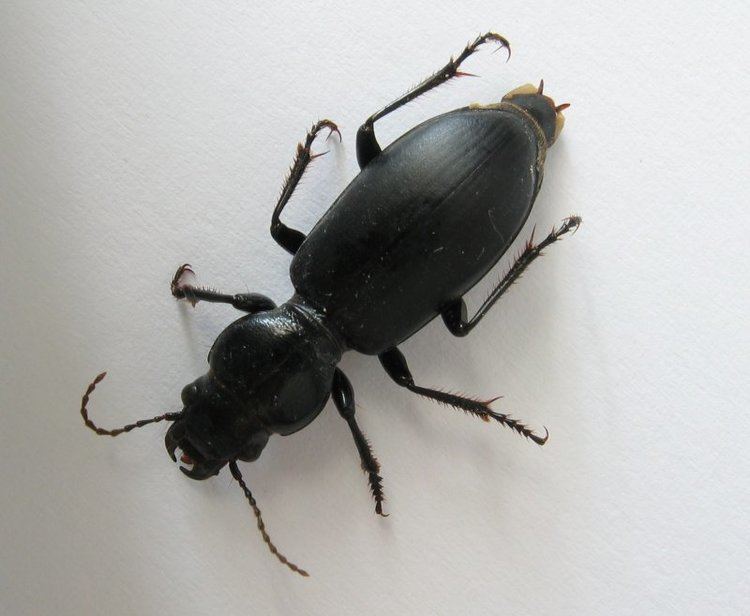 | ||
Similar Broscus, Broscinae, Cychrus caraboides, Elaphrus riparius, Carabus granulatus | ||
St evl k hlav broscus cephalotes
Broscus cephalotes is a species of nocturnal, coastal ground beetle found throughout most of Europe. Its habitat in Europe spans from western Europe into western Siberia. The species was introduced recently (circa 1975) in the eastern areas of Canada. The beetle has since spread farther south and west into the United States. The Carabidae family, of which Broscus cephalotes is a part, is generally considered as a family that is beneficial to humans due to their predatory habits. Their varied diet often includes crop pests and other small organisms.
Contents
- St evl k hlav broscus cephalotes
- Broscus cephalotes
- Description
- Feeding
- Habitat and habits
- Reproduction and Life Cycle
- Predators
- Humans and Broscus cephalotes
- References
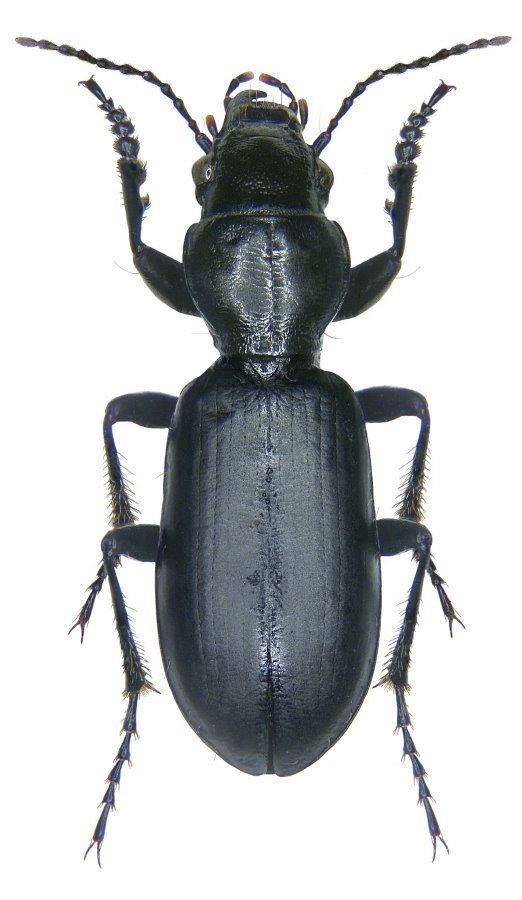
Broscus cephalotes
Description

Broscus cephalotes has a dull black coloration, without any metallic hue that is common in many beetles, and it can be quite large, anywhere from 16 to 23 mm. The morphology of the beetle is generally the same as the morphology for other beetles in its family. As ground beetles that are often found in smaller spaces (e.g. crevices under stones or under bark), the B. cephalotes has a narrower width than others in its family and is less thick. This is a flightless beetle. The shape of the body and presence or absence of the ability of flight can provide an idea of the food consumed by the beetle, but this is not conclusive and requires further study before any reliable predictions can be made. The mouthparts are a more reliable indicator of the type of food consumed by the beetle, though the best method of determining the diet of a beetle is gut dissection. The asymmetric mouthpart mandibles of the B. cephalotes are blunt and long; the length is almost double their width. The mandibles are curved to a rounded point at the end. The left mandible is slightly larger than the right mandible, both in width and in length, though the difference in length is much more noticeable. These mandibles are multi-purpose tools. The beetle uses them to create and maintain the subterranean tunnels in which they spend most of their lives. The opened mandibles can act as shovels or pull the dirt and debris from the walls of already dug tunnel. The dirt and debris are deposited outside the burrow. Additionally, the mandibles can act as shovels in the loose sand of the beetles’ coastal environment. The more obvious use of the mandibles is in feeding, as discussed below.
Feeding
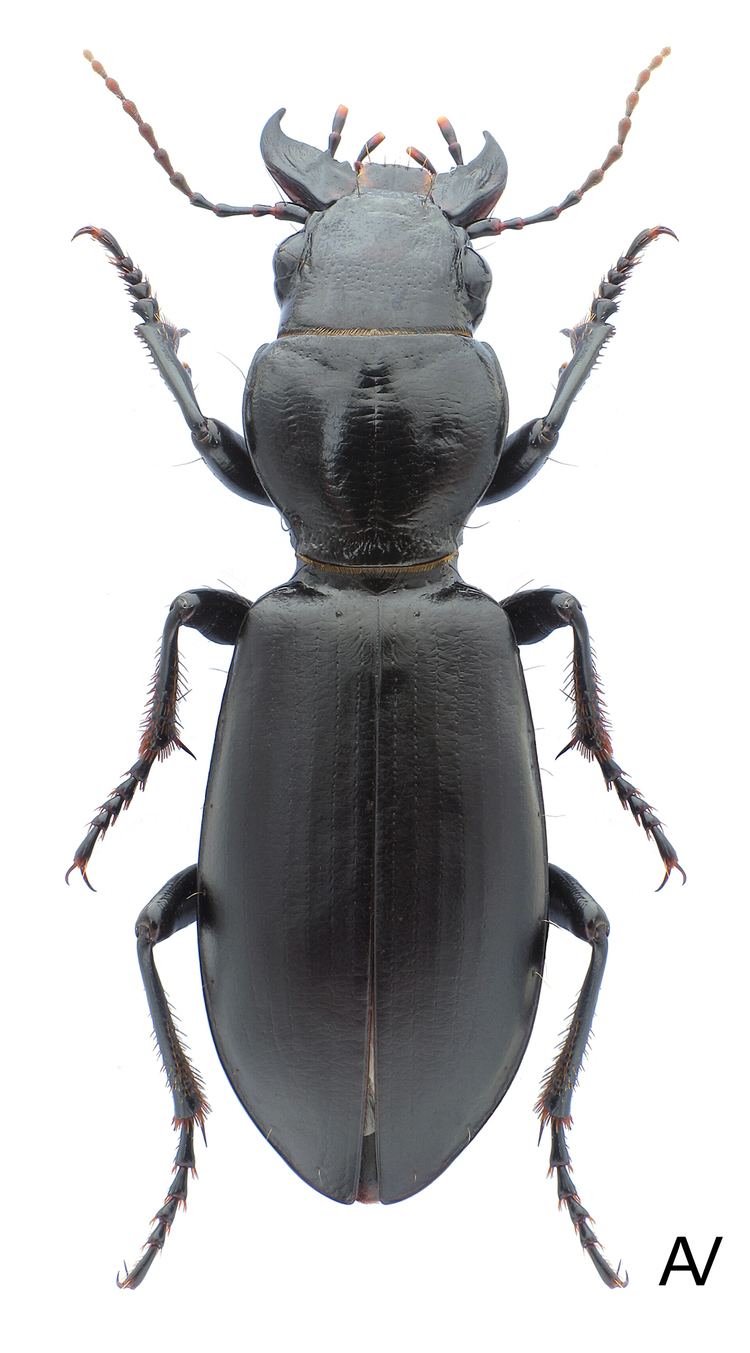
Broscus cephalotes are primarily carnivorous beetles; however they will consume a wide variety of food. They are generalists, and the adults do not discriminate much in what they consume. A recent study showed that B. cephalotes, in laboratory conditions, will attack everything that runs across the opening of its burrow, though they preferred to attack and eat woodlice and ants. Some of what has been found in various beetles’ digestive tract include: plant material, various types of ants, Lycosidae, Aphididae, Lepidopterous larvae, Diptera, Acarina, Bibionidae, Coleoptera, adult Lepidoptera, and Heteroptera. However, there has been no evidence of cannibalism in this species of beetle. The food of the larvae of this family has not been as widely studied because the larvae spend their time in subterranean tunnels and are difficult to identify even when not hidden in the soil. What has been studied of the larvae’s diet shows that the larvae are more carnivorous than their adult counterparts and more restricted diet. The limited diet may be due to their subterranean habitat and their small size. Additionally, the larvae of any Carabidae beetle tend to be fluid feeders, regardless of their status as adults.
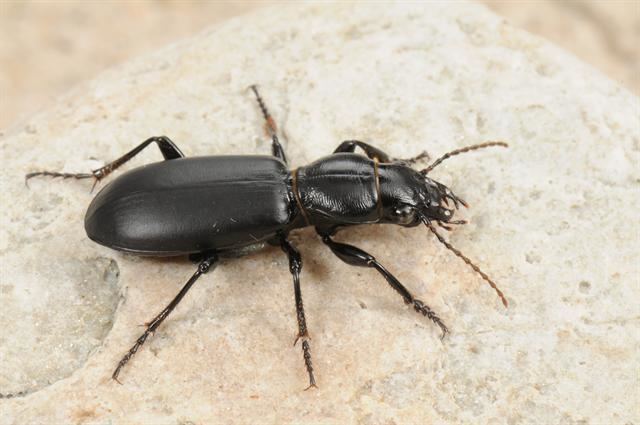
B. cephalotes has two main ways of detecting prey: tactile cues and olfactory cues. The olfactory cues, however, do not seem to be very specific, as the responses to the cue do not correspond strongly to preference of prey. The beetle, once in possession of its prey, holds the organism with its forelegs and tears off pieces of the organism to consume. The mandibles are used to tear open the cuticular structures of its meal and expose the soft tissue areas within the organism. Fluid is produced in the mouth during feeding that causes the discoloration of flesh and begins the digestive process. This fluid is composed of a variety of enzymes that begin the digestive process before the prey has entered the beetle’s digestive tract. Many samples of B. cephalotes were found to have sand in their digestive tract in addition to organisms. Sand in the digestive tract may help the beetle grind up the tougher parts of the prey, although it has not yet been determined if the sand is ingested for this purpose.
Habitat and habits
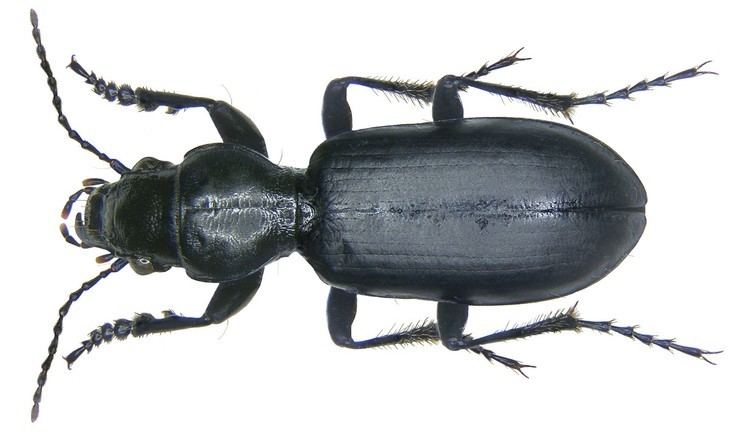
B. cephalotes can be found all across temperate western and central Europe, extending into western Siberia. Specimens are usually found in the coastal regions, but can also be found more rarely in inland Europe. It generally can be found in the vegetated dunes on the coast, but prefers the more sparsely vegetated areas.

The first appearance of B. cephalotes in North America was recorded in Nova Scotia in 1978. It seemed as though the species was well established in the area at the time, but still a relatively new arrival. The species is still confined to the eastern seaboard in North America but is much more common in Europe, although still primarily found in the coastal regions.
B. cephalotes are mostly nocturnal, although they have been seen scurrying from one hiding place to another during the day. They hide during the day burrowed under logs and stones in loose, dry sand. They have been known to rest in groups, but no evidence points to that being the norm or anything but a matter of convenience. Their nocturnal lifestyle may be helpful in the acquisition of prey. As the beetles are active during the night, they can more easily capture their prey that is diurnal. An additional advantage of the beetle’s nocturnal habit is the decreased amount of predators active while the beetle is active.
Most adults do not live through the winter, but the larvae develop during the winter months and emerge as adults in the spring and summer.
Fighting in the species has been observed under artificial daylight, but the purpose of the fighting has not been determined. Fighting could be over resources like food, or burrows or over mates.
Reproduction and Life Cycle
B. cephalotes breed in the early autumn, when the temperature is still warm and the air still dry in most of their habitats. The eggs are deposited in deep into the sandy soil of their habitats during late summer and early autumn. The site of egg deposits is determined and prepared by the female beetle. After the eggs are laid there is no parental care; it extends to choosing an appropriate site for the eggs and no further. The eggs hatch and the larvae develop in the subterranean tunnels during the winter and early spring. The larvae spend all their time below the surface, and consequently, are not well studied. Most of the knowledge of larvae is derived from a few studies and is focused on the diet of the larvae. The adult beetles emerge from the subterranean burrows in the late spring and early summer. The latest the beetles emerge in generally in early July. The period of reproduction generally spans from the end of July to mid-September, with the first larvae developing at the end of August. This can lead to some members developing on a one-year schedule and others developing on a two-year schedule. However, most die after their first year of life, only reproducing once. Some specimens have been kept alive in laboratories for much longer.
In many beetles in this family, higher temperatures correlate to long reproductive periods and more eggs laid. Lower temperatures correlate to a shortened reproductive period and fewer eggs produced, despite the presence of an abundance of food. However, laboratory settings may give a skewed view on the reality of these beetles. There have not been any comprehensive field studies regarding the effect of temperature on reproductive success in Carabidae beetles of any type.
Predators
Among the predators of B. cephalotes are birds which need these and other invertebrates to create a protein-rich diet for their chicks. Some species of corvid and raptor birds have the Carabidae family compose of a significant amount of the adult diet as well. Farmland birds in particular depend heavily on the presence of the Carabidae family. Small mammals, amphibians and reptiles also prey on the Carabidae family, B. cephalotes included. All European bats are protected, and many of these bats specialize in preying on beetles. Mammals, such as hedgehogs, shrews and mice inhabiting areas far from crops often consume these beetles. The beetles constitute a significant (20%) portion of these mammals’ diet in June. This is primarily due to the beetles’ life cycle. Most of the beetles, that matured during the winter and spring, emerge in June, live throughout the summer and fall, reproducing in the fall, and dying during the winter. Thus there is a surplus of beetles in June of which most mammals take advantage.
Humans and Broscus cephalotes
In Britain, there has been a large reduction in the area covered by heath lands over the past 150 years. This reduction has been largely due to human activity; expanding industrial and residential areas have reduced the available and habitable heath land. While the heath lands are not known for diversity in flora, the invertebrate fauna in the region rely on the heath lands for survival. The remaining habitats in Britain are cut through and connected by roadways. There has been concern in the past that roadways disrupt the habitats of B. cephalotes and that the roads lead to the insects surviving but not breeding. However, recent studies show that the sandy roadsides can link habitats and create refuges for the beetles. This leads to greater survival and reproduction in the ground beetle population.
It is in farmers’ interests for these beetles to continue surviving and reproducing successfully. B. cephalotes have long had the potential to be useful to farmers. Many of their prey fall under the category of crop pests, such as aphids, slugs and dipteran eggs. This has been recognized at least since the early nineteenth century. However, it is only recently that arable farmers have begun to consider these beetles in their crop rotations. This renewed interest in the role of beetles in crop rotations is due to many factors; some of which are: the decreased value of crops and pressure from environmental groups to decrease the use of pesticides and other farming practices that are detrimental to the environment. Most of the more recently adopted farming practices (e.g. selective insecticides and augmenting non-crop habitat) will affect the population of ground beetles, but not immediately. Pest management effects will not be noticeable until more extensive measures are implemented.
